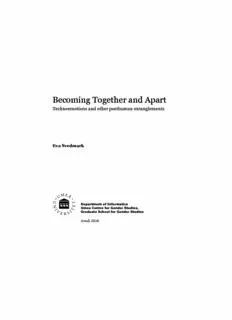
Becoming Together and Apart PDF
Preview Becoming Together and Apart
Becoming Together and Apart Technoemotions and other posthuman entanglements Eva Svedmark Department of Informatics Umea Centre for Gender Studies, Graduate School for Gender Studies Umeå 2016 This work is protected by the Swedish Copyright Legislation (Act 1960:729) ISBN: 978-91-7601-487-5 ISSN: 1401-4572 RR 16.01 Cover design: Johan Bodén Cover illustration: Adam Stolterman Illustrations Act 2: Adam Stolterman Figures Act 3: Johan Bodén Photos when not stated othervice: Eva Svedmark This book is also available in an electronic version at: http://umu.diva-portal.org/ Printed by: Print & Media Umeå, Sweden 2016 Tandem Musca Cacavit Table of Contents Abstract ix Acknowledgements xi Playlist xiv Sammanfattning på svenska xv Act 1 Setting the scene 1 1. Introduction 3 The story begins 3 Social media 3 Negotiations of social norms 5 Norm-breaking sharing 6 Uncomfortable science 7 Aim(s) and research questions 11 Disposition 12 2. Transdiciplinary foundations 17 “New” Media and the birth of Web 2.0 17 Social media in numbers 18 Sharing as norm 19 Public privacy 20 Technology and the user 22 Designing a future 24 3. Projects involved 27 A variety of material 27 Some words on qualitative methodology 28 Project 1: IT for a Quality of Life 28 v Project 2: Umea Live 30 Project 3: Sexual Online Exposure Among Youth & Young Adults 33 Project 4: When life hurts 34 Tables of collected data 36 4. Perspectives 41 Being a modest witness with a feminist agenda 41 Me as the Situated Knower 45 Technoscience 47 Feminist Technoscience 47 Posthumanism (and the speaking of things) 49 5. Digital Dirt, Cuts and Choices 53 Finding Sticky Stories 53 Digital Dirt 54 Coming close 56 Making distance 57 Cuts 58 6 Ethics 61 With internet as my arena 62 Researching Life’s Difficulties 64 Potential problems with informed consent 66 Confidentiality requirements 71 Seeing ethics as a process 76 Act 2 Articulating the Phenomenon 79 7. Giving voice to the unheard 81 The limits of writing 83 Narratives and emotions 84 vi Getting my hands dirty 85 8. Bodies 87 The Sexed Body 89 The Starved Body 92 The Scarred Body 95 9. Emotions 101 Grief 102 Suicide 112 Fear 129 10. The Others 131 Speculators 132 Helpers 134 Lurkers 134 Other others 135 11. Things 137 Software 137 Hardware 139 Anywhere 140 Act 3 Making sense 143 12. Staying with the trouble 145 13. In search of the apparatus 147 Finding a way 148 Moving within entanglements 150 14. Performing feminist technoscience 153 Diffraction as metaphor 154 Diffraction as methodology 156 vii Touch as onto-epistemology 160 15. TechnoEmotions 163 (dis)Trust 166 (fiction)Truth 170 (dis)Embodiment 174 (eternal)Time 179 … and other Posthuman Entanglements 181 Act 4 The End of a Beginning 185 16. Critical alternatives 187 Reconfiguring the future 188 Hope 193 Epilog 195 References 197 Research Reports 217 Notes 227 viii Abstract Social media has in its relatively short existence become a natural arena for people of all generations to inhabit and live significant parts of their life. People of all ages are forming personal strategies for their social media presence and absence and most of us are using internet not only for information and services but also as social arenas for sharing experiences of fun and joy, communication and friend making. What we share and not in social media is slowly changing and it seams like there is a slow shift in the norms surrounding what we share and not. This thesis is focusing on the extreme norm-breaking online sharing by entering material of a kind that most people never encounter (suicide, self-harm, mental illness). Using social media and norm-breaking material as an empirical touchstone this thesis elaborates, investigates and explores the entangled relationships between humans and technology in social media settings. Guided by uncomfortable, emotional and bodily online sharing the thesis gives voice to stories that are seldom heard, by people whose lives are rarely spoken of. By exploring the performative entanglements of/with/through technology, design and human intent the overall aim is to offer a critical and new understanding of our online togetherness and posthuman becoming. The conceptual framework throughout the thesis is based on posthuman theory and feminist technoscience, two closely connected theories providing a new onto-epistemological way of understanding the world’s becoming. The thesis should be seen as the product of an empirical practice of making theory about digital things, culture, humans and non-humans. By exploring diffraction and touch as not ix only theoretical standpoints but also hands-on methodology the thesis contributes to the development of new ways of doing research. Important findings arising from the practice of diffraction and touch are Technoemotions – conceptually agents built on a posthuman understanding of how emotions are entangled between and within the phenomenon, becoming important agents in the apparatus creating the phenomenon. Four Technoemotions seem particularly prominent in the material: Trust, Truth, Time and Embodiment. The thesis concludes by providing a discussion on critical alternatives for ethics, politics and power in relation to social media and the norms and norm-breaking practices most of us participate in. The responsibility and ability to respond are addressed, as well as social justice and hope for the future to come. x
Description: